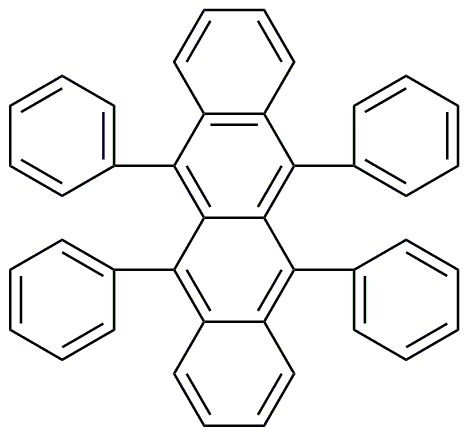Rubrene is widely utilized in research focused on:
- Organic Electronics: Rubrene is a key material in organic light-emitting diodes (OLEDs) and organic photovoltaics (OPVs), enhancing efficiency and performance due to its excellent charge transport properties.
- Sensor Technology: Its high sensitivity to environmental changes makes rubrene ideal for developing chemical sensors, particularly in detecting gases and volatile organic compounds.
- Pharmaceutical Research: Rubrene's properties are explored in drug delivery systems, where it can improve the solubility and bioavailability of certain medications.
- Photonic Devices: Used in the fabrication of photonic devices, rubrene contributes to the development of advanced optical components, benefiting telecommunications and data transmission industries.
- Research on Organic Semiconductors: As a model compound, rubrene plays a crucial role in studying the behavior of organic semiconductors, aiding the development of next-generation electronic devices.
General Information
Properties
Safety and Regulations
Applications
Rubrene is widely utilized in research focused on:
- Organic Electronics: Rubrene is a key material in organic light-emitting diodes (OLEDs) and organic photovoltaics (OPVs), enhancing efficiency and performance due to its excellent charge transport properties.
- Sensor Technology: Its high sensitivity to environmental changes makes rubrene ideal for developing chemical sensors, particularly in detecting gases and volatile organic compounds.
- Pharmaceutical Research: Rubrene's properties are explored in drug delivery systems, where it can improve the solubility and bioavailability of certain medications.
- Photonic Devices: Used in the fabrication of photonic devices, rubrene contributes to the development of advanced optical components, benefiting telecommunications and data transmission industries.
- Research on Organic Semiconductors: As a model compound, rubrene plays a crucial role in studying the behavior of organic semiconductors, aiding the development of next-generation electronic devices.
Documents
Safety Data Sheets (SDS)
The SDS provides comprehensive safety information on handling, storage, and disposal of the product.
Product Specification (PS)
The PS provides a comprehensive breakdown of the product’s properties, including chemical composition, physical state, purity, and storage requirements. It also details acceptable quality ranges and the product's intended applications.
Certificates of Analysis (COA)
Search for Certificates of Analysis (COA) by entering the products Lot Number. Lot and Batch Numbers can be found on a product’s label following the words ‘Lot’ or ‘Batch’.
*Catalog Number
*Lot Number
Certificates Of Origin (COO)
This COO confirms the country where the product was manufactured, and also details the materials and components used in it and whether it is derived from natural, synthetic, or other specific sources. This certificate may be required for customs, trade, and regulatory compliance.
*Catalog Number
*Lot Number
Safety Data Sheets (SDS)
The SDS provides comprehensive safety information on handling, storage, and disposal of the product.
DownloadProduct Specification (PS)
The PS provides a comprehensive breakdown of the product’s properties, including chemical composition, physical state, purity, and storage requirements. It also details acceptable quality ranges and the product's intended applications.
DownloadCertificates of Analysis (COA)
Search for Certificates of Analysis (COA) by entering the products Lot Number. Lot and Batch Numbers can be found on a product’s label following the words ‘Lot’ or ‘Batch’.
*Catalog Number
*Lot Number
Certificates Of Origin (COO)
This COO confirms the country where the product was manufactured, and also details the materials and components used in it and whether it is derived from natural, synthetic, or other specific sources. This certificate may be required for customs, trade, and regulatory compliance.


